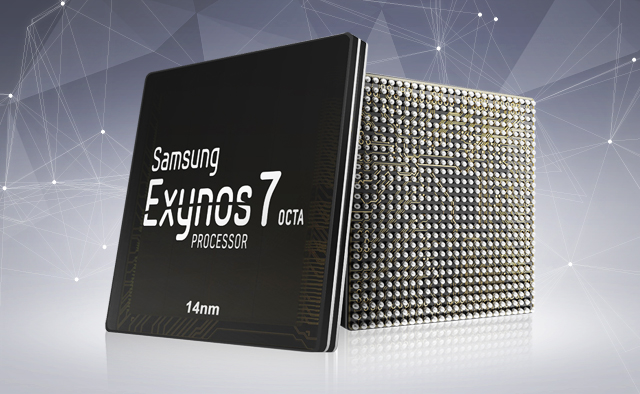We took our last day in Barcelona on site to test the performance of the Samsung Galaxy background S6 and out. We were able to reproduce our usual test protocol for measuring synthetic performance, application and videogames. It cuts short any suspense: S6 Galaxy is good, very good even
Each release of new flagship stores, this is the race benchmarks to see which will be the most powerful.. For some users, these measures have no interest. But for others, it is the sinews of war. In all cases, the benchmarks are very helpful and even if they are not completely reliable, they can have a first objective approach with the terminal. We wanted to know what gave the Galaxy S6 quite recently unveiled by Samsung. We could play an hour with several terminals to test the CPU, the GPU, but also the new flash memory UFS.
Analysis of the Exynos 7420
With the Galaxy S6, Samsung has surprised a lot of people. Indeed, the Korean manufacturer has just given up on the proposed Qualcomm Snapdragon 810 and to devote himself to an internal solution, the Exynos Octa 7 (7420). It’s been a long time that Samsung had not proposed a flagship in only one version . Usually, you are entitled to an Asian version incorporating a Exynos and a second dedicated to Europe and the United States with a Snapdragon. You actually go back to the first Galaxy S name to find such a situation. Back to basics at the technical level that has paid off, as we shall see later.
| Exynos 7420 | Exynos 5433 | Snapdragon 810 | |
|---|---|---|---|
| CPU | 4 x Cortex-A57 (2.1 GHz) 4 x Cortex-153 (1.5 GHz) | 4 x Cortex-A57 @ 1.9 GHz 4 x Cortex-A53 @ 1.3 GHz | 4 x Cortex-A57 @ 1.96 GHz 4 x Cortex-A53 @ 1.5 GHz |
| GPU | Mali-T760 MP6 | Mali-T760 MP6 | Adreno 430 |
| RAM | LPDDR4 (2x 32-bit @ 1555MHz) | LPDDR3 (2x 32-bit @ 825 MHz) | LPDDR4 (2x 32-bit @ 1555MHz) |
| Architecture | aarch64 | armv7l | aarch64 |
| Burning | Samsung 14nm FinFET | Samsung 20nm | TSMC 20nm |
| Storage | UFS 2.0 | eMMC | eMMC |
Recently, the head of the mobile division of Samsung announced the partnership with Qualcomm remained still current. But he added that his company chose the best chips in the consumer’s interest and it would seem that the Snapdragon 810 did not meet the specifications . This maneuver also reduces dependence with the firm of San Diego
14nm. Formidable weapon the Samsung
When you look a little more details about the Exynos 7420, we can easily understand why Samsung chose not to make a version of its Snapdragon 810 high-end terminal. The Korean giant chip differs in one crucial respect: it is engraved in 14nm FinFET against 20 nm for the chip from Qualcomm. Unlike the use of such a process: a more compact chip therefore easier to integrate into a compact smartphone, and especially consumption and heated further mastered. Samsung talks about a consumption down 30% compared to 20nm for performance up 20% . It would have been very difficult from Samsung to offer two terminals so different from this point of view, either for integration, but also from a marketing perspective.

This strategic choice could not be achieved by a company other than Samsung. The Korean giant is one of the few founders of the planet. A foundry is a company capable of producing chips not just to design. Samsung for its part designs and manufactures its chips. Best of all, Samsung is one of the few skiers to join the inner circle of the FinFET etching 14nm . Aside from the Korean giant, only Intel is able to bring out chips so en masse. TSMC should also be able to, but in a few months, especially for the Snapdragon 820.
The Bar 2 GHz exceeded
With only a engraving in 14nm, the Exynos 7420 portends good performance. When analyzing a little more detail the SoC (with the details we have at the moment), we arrive at the same conclusion. Indeed, the chip consists entirely of two groups of four cores: the Cortex-A57 clocked at 2.1GHz on one side and Cortex-A53 clocked at 1.5 GHz on the other. The frequency of 2.1 GHz is very high for this type of hearts and Samsung has certainly benefited from the 14nm engraving to exceed the 2 GHz mark, or there Snapdragon 810 is stuck below 2 GHz.
The first true 64-bit chip Korean
A quick word about the management of the 64-bit instruction set. The rumors were confirmed: the Exynos 7420 is the first mobile chip Samsung support the 64-bit instruction set supported by Lollipop . The Exynos 5433 has the same types of hearts, but the Galaxy Note 4 under Korean Lollipop sticks in 32 bits. The proof of CPU-Z, the architecture of the Galaxy S6 is aarch64 kind against armv7l for the Galaxy Note 4 Exynos. The reason could come from the torque firmware / drivers as Anandtech supposed end of last year. The 64-bit instruction set support is expected to slightly improve performance . . Nothing too crazy speaking of a few percent at most in specific cases (decompression, for example)
To go along with this heart octo-processor, Samsung has integrated graphics chip ARM: the Mali-T760 MP6. We know already, since it was present in the Korean Galaxy Note 4 and 7 Eynos Octa (5433) etched 20 nm. Finally, RAM, Samsung now uses the LPDDR4-1554 (2 x 32 bit) instead of LPDDR3-1066 (2 x 32 bit) for the Exynos 5433. The bandwidth is up sharply, which will be felt in performance . Finally, for storage, Samsung has abandoned the eMMC memory to upgrade to the new UFS 2.0 memory that still uses NAND memory chips, but is distinguished by its more efficient architecture.
The results of performance tests
Now that we have analyzed the hardware architecture of the Samsung Galaxy S6′s tackle the practical part.
For the CPU part, we are based on synthetic and application benchmarks: AnTuTu and PCMark. For the GPU, we use 3DMark Ice Storm Unlimited GFXBench, BaseMark X and GameBench to measure performance on part of 15 minutes of Real Racing 3 adjusted Xtra High mode (1080p). Finally, the UFS memory was measured with 2.0 AndroBench.
To see a little more clearly from the competition and the Exynos 5433, we compared the results with Qualcomm tablet and development its Snapdragon 810 and with the Galaxy Note 4 Korean version.
| Galaxy S6 | MDP 810 Tablet | Galaxy Note 4 (Asian) | |
|---|---|---|---|
| SoC | Exynos 7420 | Snapdragon 810 | Exynos 5430 |
| Definition | QHD (1440p) | UHD (4K) | QHD (1440p) |
| AnTuTu 5.1.5 | 61,150 | 54386 | 48000 |
| PCMark | 5000 | 4166 * | 4131 |
| 3DMark Ice Storm Unlimited Total | 22,265 | 24549 | 20316 |
| 3DMark Ice Storm Unlimited Graphics | 23,630 | 33545 | 15341 |
| 3DMark Ice Storm Unlimited Physics | 18,521 | 12663 | 22390 |
| GFXBench T-Rex (onscreen / offscreen) | 19.1 / 47.1 FPS | 39/57 FPS | 21.9 / 37.6 FPS |
| GFXBench Manhattan (onscreen / offscreen) | 7.6 / 23.3 FPS | 16/26 FPS | 10.7 / 17.3 FPS |
| Real Racing 3 | 41 FPS | – | 33 FPS |
| Read / write sequential | 318/143 MB / sec | – | 212/117 MB / s |
| Read / write random | 20,023 / 5,146 IOPS | – | 5 755/2608 IOPS ** |
* measurements performed on a HTC One M9
** measurements Galaxy Note on Edge
A high-performance CPU
As can be seen in the table, the Samsung Galaxy S6 is very strong. The Exynos 7420 SoC is a very good, very powerful. The high frequency of its processor allows it to position before the Snapdragon 810 (SoC which equips the HTC One M9) highly dependent on the CPU tests. This is the case of AnTuTu, PCMark or physical 3DMark test.
GPU almost on top
In the GPU on the other hand, the Galaxy S6 is positioned slightly behind the Snapdragon 810. The difference between 20 and 50% depending on the case, GFXBench and graphics tests 3DMark . The Adreno 430 seems to be in front of the Mali-T760 MP6 used by Samsung.
However, Real Racing 3, Galaxy S6 admirably doing well . Certainly, it fails to achieve a constant framerate of 60 FPS, but this is the first Samsung device to get by as well. One might think that this good performance is permitted by the 14nm engraving that avoids heat the chip and therefore reduce the frequency of the GPU. But in fact, the Mali-T760 is MP6 allows advanced 544 MHz before collapsing to 266 MHz for the entire test duration (15 minutes) after one minute of charging. At first glance, the Adreno 430 is before the Mali-T760 MP6 but it will check this as Real Racing 3 since with the Galaxy Note 4, we recall that the Korean version was more efficient in the running game, but less efficient in the benchmarks.
A high memory bandwidth
In fact, good graphics performance is rather to be sought in the RAM. With the choice of LPDDR4-1554, Samsung has almost doubled the bandwidth compared to the LPDDR3-825 the Exynos 5433 (24.8 against 13.2 GB / s). The GPU is very greedy in memory bandwidth, the more it is increased, the graphics chip’s performance will be good. If the GPU could no longer maintain its maximum frequency (as did the Snapdragon 810 in development tablet, unlike the LG G Flex 2), we might have achieved superior performance chip Qualcomm.

Speaking of memory, we can quickly address the chip flash memory architecture organized around a UFS 2.0. As can be seen, the gain from the eMMC chip Galaxy Note Edge is obvious . Sequential reading increases almost 100 MB / s against a 22% increase for writing. In addition, the number of operations per second (IOPS) is considerably higher, which should allow in practice to benefit from time savings during multiple small operations (installation of an application, for example).
A high-performance smartphone
In conclusion, the S6 Galaxy is a very powerful smartphone. We have not been able to perform measurements on the Galaxy S6 edge, but the results should be similar. Subsequently, it will obviously do further tests including at its self that should be pretty good with an engraving in 14nm and an AMOLED screen that shows the improvements made by the LTE Galaxy S5 -TO. Finally, it will compare the Exynos 7420 to 810 at the Snapdragon HTC One M9 to measure the Qualcomm SoC behavior in a device other than the G Flex 2 development or tablet.
Find all the news MWC 2015 →
No comments:
Post a Comment